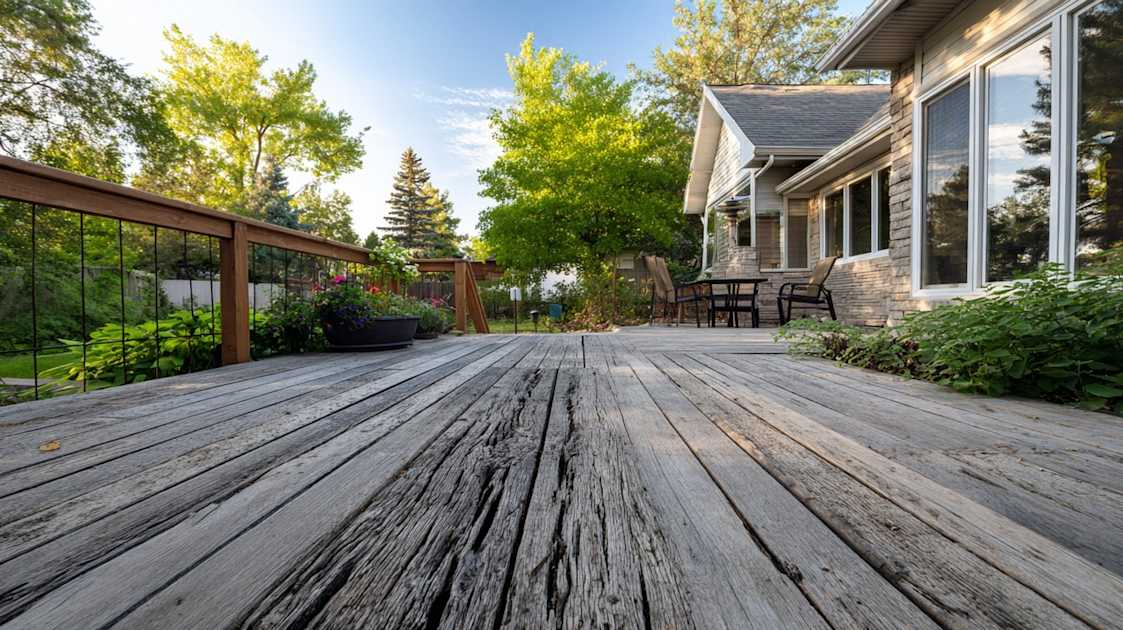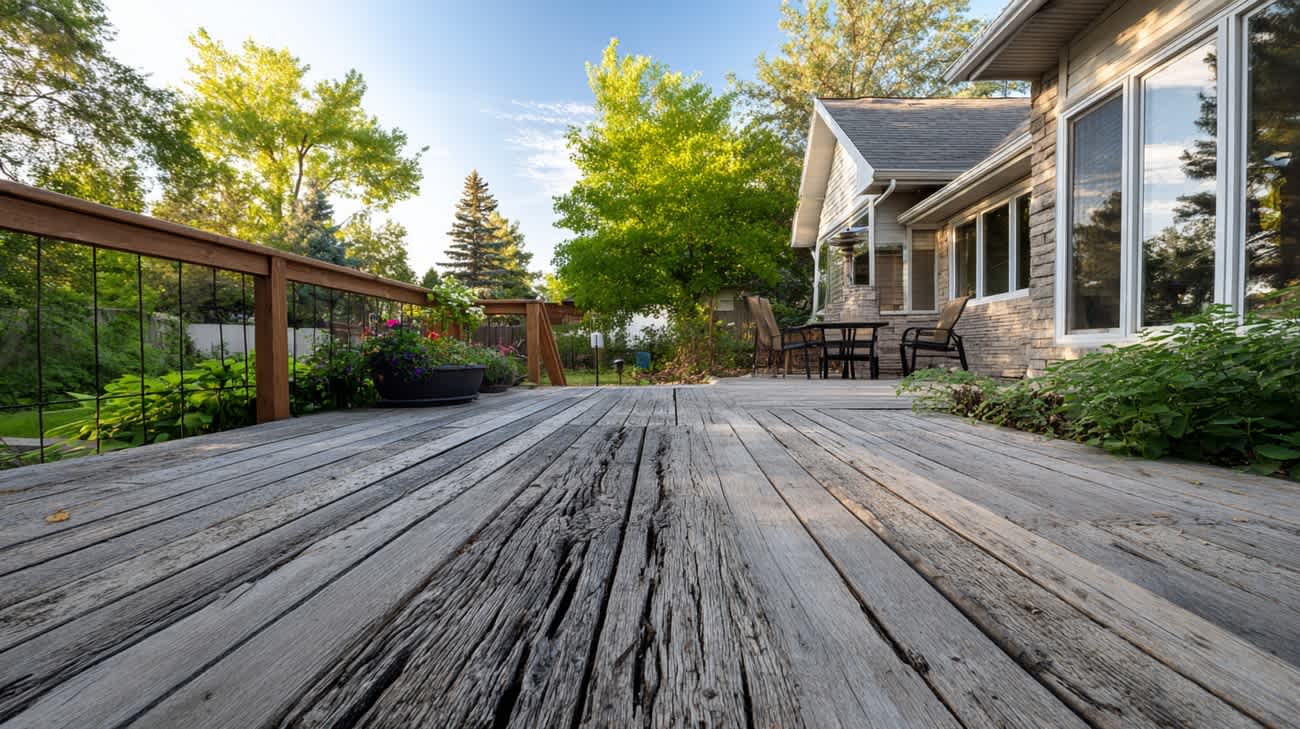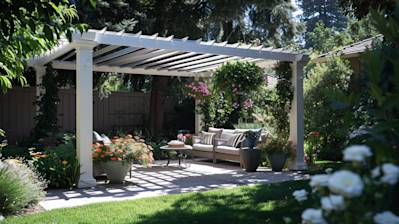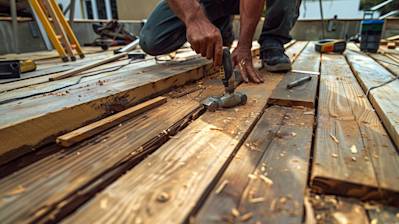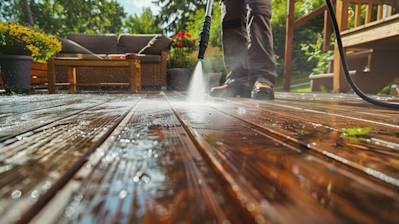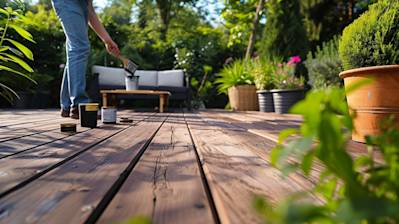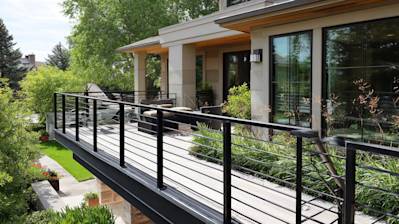When it comes to maintaining your home's exterior, your deck plays a crucial role in providing a functional and aesthetic outdoor space. Regular maintenance can prolong a deck's lifespan, but there eventually comes a time when you need to consider replacing it. In this guide, we'll help you determine when that time has arrived, explore signs of wear, and discuss the benefits of timely replacement. Let's delve into the details to ensure your deck remains safe and beautiful for years to come.
Recognizing the Signs
Structural Problems
The foundation of any deck is its structure, which includes posts, beams, and joists. Over time, these components may become compromised:
- Inspect Wooden Beams: Wood tends to rot over time. If you notice soft spots, excessive splintering, or decay in the beams, it's likely time for a replacement.
- Post Stability: Wobbly or leaning posts are a safety hazard. These issues can occur from poor installation or ground erosion and may necessitate a full rebuild.
- Sagging Deck Boards: Deck boards that sag or feel springy underfoot could indicate weakened structural support.
Surface Issues
While structural problems demand immediate attention, surface issues can also impact the usability and appearance of your deck:
- Cracked or Splintered Boards: Constant exposure to the elements can lead to surface damage, making your deck uncomfortable and potentially hazardous for bare feet.
- Fading and Discoloration: Although cosmetic, significant fading may indicate the wood's protective coating has worn off, leaving it vulnerable to water damage.
Rust and Metal Complications
Decks often include metal components like screws and brackets, which require periodic inspection:
- Rusty Fasteners: Rust on screws, nails, and brackets can compromise the deck's integrity and should be replaced. If rust is widespread, a replacement may be necessary.
- Loose Railings: Loose railings pose a significant safety risk. Check for secure connections and firm fastenings.
Lifespan and Material Consideration
Comparing Material Longevity
The materials used in deck construction greatly influence its lifespan:
- Pressure-Treated Lumber: Generally lasts 10-15 years with proper maintenance.
- Cedar and Redwood: Known for natural resistance to rot, these woods can last 15-20 years.
- Composite Decking: Made from a mix of wood fibers and plastic, composite decks often last 25-30 years and require less upkeep.
- Aluminum Decking: This material can last more than 30 years, providing excellent durability and minimal maintenance.
Assessing Age and Wear
Once you understand what your deck is made of, evaluating its age in tandem with visual damage helps in estimating when it's due for replacement. A deck reaching the upper limits of its expected lifespan with multiple signs of wear is a strong candidate for replacement.
Benefits of Deck Replacement
Enhanced Safety
A new deck eliminates wobbling railings, unstable steps, and weak boards, creating a safer environment for family gatherings and enjoyment.
Boosting Aesthetic Appeal
A fresh deck dramatically improves your home's curb appeal, providing a clean and vibrant outdoor space that invites relaxation and entertainment.
Increasing Property Value
Especially when considering selling your home, a new, well-maintained deck can increase its market value. Buyers often appreciate outdoor living spaces, and a brand-new deck can make a significant difference in your property's desirability.
Step-by-Step Evaluation Process
Considering an evaluation process helps to systematically assess your deck's condition:
- Inspect Regularly: Conduct a thorough check at least once a year, noting any minor issues.
- Record Damages: Keep a log of any damages such as cracks, rot, or rust.
- Professional Assessment: For older decks, hire a professional to evaluate the structure, especially if safety concerns arise.
- Budget for Replacement: Set a budget aside for potential replacement as your deck nears the end of its lifespan.
Signs Replacement Is Imminent
Here's a quick checklist:
- Significant structural issues such as foundational shifts or heavy wood rot.
- Board splitting, warping, or major surface damage beyond repair.
- Substantial rust on metal components.
- Outdated appearance severely affecting aesthetics and property value.
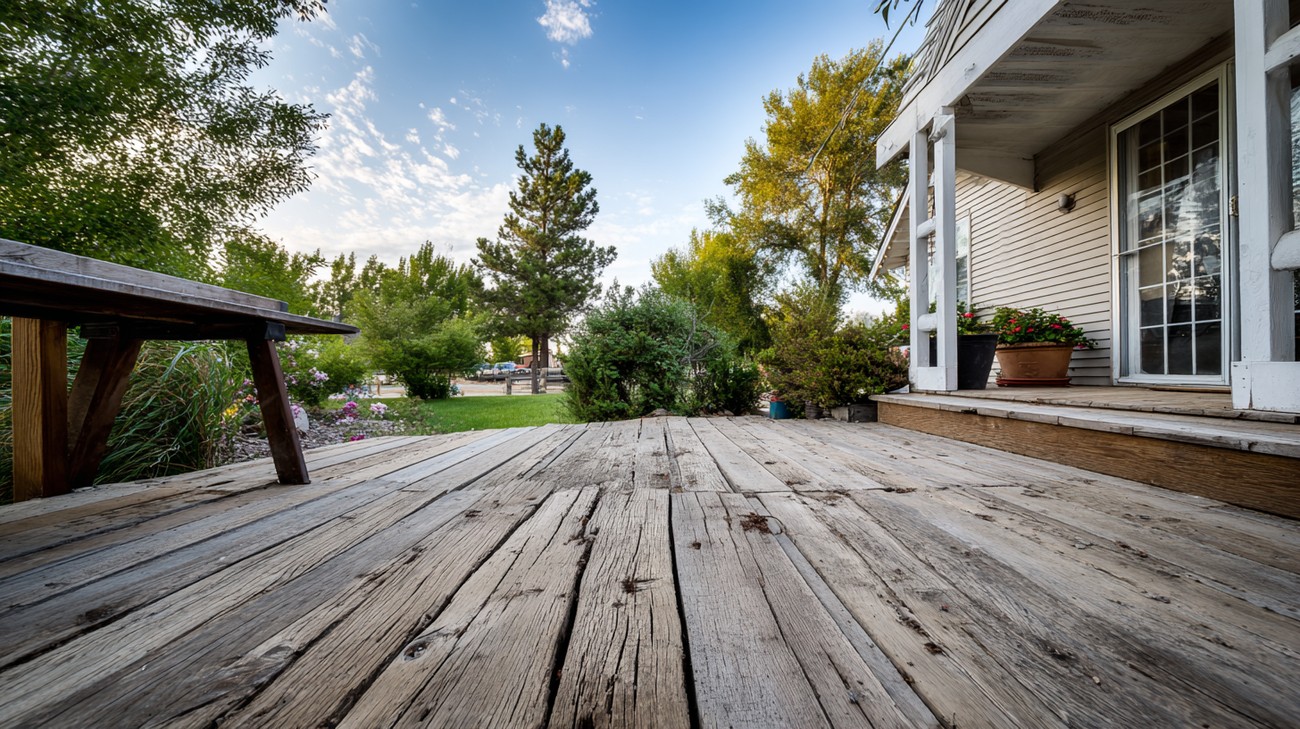
Frequently Asked Questions
How long do most decks typically last?
The lifespan of a deck can vary significantly based on the materials used and the care it receives. On average, wooden decks last between 10 to 15 years. Composite decks, which are made of plastic and wood fiber, can last 25 to 30 years with proper maintenance. Climate and weather conditions also play a big role — decks in harsh climates with severe winters or blistering summers may have shorter lifespans. Regular inspections and maintenance will maximize your deck's longevity, but eventually, you may face the decision of when to replace your deck.
What are the risks of not replacing an old deck in time?
Failing to replace an aging or deteriorated deck can lead to serious safety hazards. As the materials degrade, there is an increased risk of the deck collapsing or individual boards breaking underfoot. This not only poses a risk to those using the deck but can also result in damage to property or injury. An old deck may also become host to mold and mildew, which could cause health problems for people with allergies or respiratory issues. Moreover, you might face higher costs later by delaying replacement, as the deterioration could lead to more extensive structural damage.
How does regular maintenance impact the decision to replace a deck?
Regular maintenance can significantly delay the need to replace a deck. By consistently cleaning, sealing, and repairing small damages, you can extend the life of your deck. For wooden decks, applying a fresh coat of sealant every couple of years will protect the wood from moisture and sun damage. Repairs to splintered wood or reinforcement for loose handrails also help maintain safety. However, if maintenance becomes more frequent and costly over time, it may be more economical to consider replacing the deck entirely.
Can I replace only a part of my deck instead of the whole thing?
Yes, sometimes replacing just a part of your deck is a practical option, especially if only a specific area has suffered damage. For instance, if just a few boards are warped or a railing is loose, you can replace individual components rather than the entire deck. However, keep in mind the age and overall condition of the deck when making this decision. If your deck is reaching the end of its expected lifespan or has widespread damage, a full replacement might be more efficient and safer in the long run.
What signs indicate the foundation of my deck is failing?
Signs that the foundation of your deck is failing are crucial to know since they affect the entire structure's safety. Check for sinking or shifting footings, which can occur when the soil underneath your deck compresses or erodes. Cracks in concrete footings or a gap forming between the deck and the house can also indicate foundation issues. If beams or joists appear warped, cracked, or overly moist, this could mean that the foundation is compromised and a deck replacement should be considered. Catching these signs early can prevent accidents and more costly repairs.
What are the environmental factors that can speed up the need for a deck replacement?
Several environmental factors can lead to a faster replacement of your deck. Constant exposure to sunlight can cause fading and deterioration of the decking material, especially wood, leading to cracks and splintering. Moist climates can promote mold, mildew, and rot, all of which can reduce the structural integrity of the deck. Severe weather events such as hurricanes and heavy snowfall might damage or warp the decking material. Regularly adapting maintenance plans to these environmental conditions can help delay the inevitable decision of when to replace a deck.
How can I finance a deck replacement?
Financing a deck replacement can be achieved in several ways depending on your financial situation. Home improvement loans are a common choice, allowing you to borrow money specifically for renovating or replacing structures like decks. Another option is a home equity line of credit (HELOC), which leverages the value of your home. Some homeowners use personal savings, but this requires advance budgeting and discipline in saving. Finally, some contractors offer financing plans, allowing you to pay for the deck incrementally. Consider consulting with a financial advisor to explore which option best suits your needs. ```

Weighing Your Options: When to Replace a Deck
Replacing a deck is a big decision that involves careful consideration of various factors. From evaluating the condition of your old deck to considering the impact on lifestyle and home value, there’s a lot to think about. Let's dive into the pros and cons of replacing your deck so you can make an informed decision.
Pros
Enhance Aesthetic Appeal
Replacing your deck can dramatically enhance the overall look of your outdoor space. If you’re tired of the old, worn-out appearance, a fresh start can revitalize your home’s exterior and boost its curb appeal. It’s like giving your house a mini-makeover!
Increase Home Value
A new deck can be a fantastic investment for your property. High-quality materials and excellent craftsmanship could potentially raise your home's value. Prospective buyers often view a new deck as an attractive feature that enhances the living space.
Improved Safety
Let's face it, a rickety deck with wobbly railings and creaky boards isn’t just an eyesore—it’s a safety hazard. Replacing your deck helps ensure that your outdoor space meets safety standards, protecting your family and guests from potential accidents.
Modern Features
With a new deck, you have the freedom to incorporate modern features and technology. Whether you want to install built-in lighting, integrated seating, or even a hot tub, starting from scratch allows you to customize the deck of your dreams.
Minimal Maintenance
Older decks often require constant upkeep to maintain their appearance and functionality. By replacing your deck with durable materials like composite decking, you can significantly reduce the amount of maintenance required, leaving you with more time to enjoy it.
Cons
High Upfront Cost
One of the most significant drawbacks of replacing a deck is the cost involved. Quality materials and professional installation can be pricey. Even though it might be a worthwhile investment, the initial expense can be a burden if not planned carefully.
Time-Consuming Process
Replacing a deck isn't a weekend project. It can take several weeks from planning to completion, depending on factors like design complexity and weather conditions. This might disrupt your outdoor activities, especially during the prime deck usage months.
Permitting and Legalities
Depending on where you live, replacing a deck could mean navigating through a mess of permits and local regulations. It’s crucial to ensure that the new construction complies with building codes, which can sometimes be a hassle and delay the process.
Environmental Impact
If you’re eco-conscious, the idea of discarding an old deck can be daunting. The construction and disposal of materials can have a significant environmental footprint. It’s worth considering recycled or sustainable materials if this is a concern for you.
Emotional Attachment
Sometimes, decks hold sentimental value, filled with memories of family gatherings and summer barbecues. Replacing it with a new one might mean saying goodbye to those cherished moments. It’s important to weigh sentimental considerations alongside practical ones.
Deciding when to replace your deck involves a careful balancing act of financial, emotional, and practical factors. By examining the pros and cons, you'll be better prepared to make a decision that suits your circumstances.

Summary
When to replace a deck really comes down to keeping an eye on the condition of the wood and the safety of the structure. If you see boards that are rotting, feeling weak or wobbly spots when you walk, or if there are a lot of nail or screw pops, it's definitely time to think about replacing it. Then there's the cosmetic factor—if your deck just looks like it’s seen much better days, a new one could improve your space and make it more enjoyable. Plus, if repairs are costing more than just building a new deck, replacement might actually save you money in the long run. So, whether it's for safety, appearance, or the wallet, knowing when to replace a deck is all about putting those signs together to make a call that keeps everything safe and enjoyable.
Tags: time, deck condition, safety,


